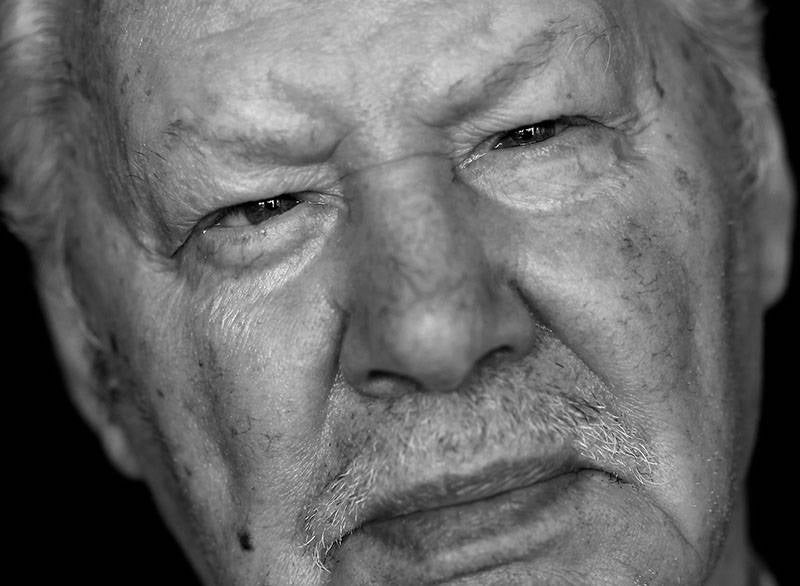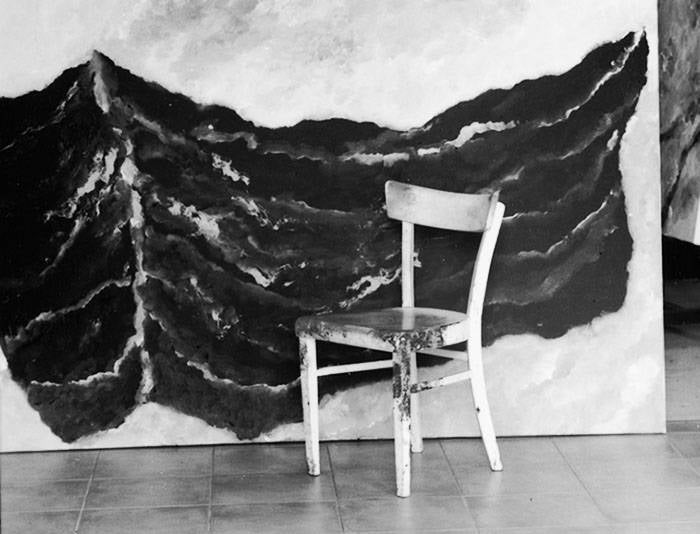
1929
- Born in Amsterdam on 18 September.
1935-1950
- Lives in Amersfoort, close to the grounds on which the Polizeiliches Durchgangslager Amersfoort, commonly known in the Netherlands as “Kamp Amersfoort”, is set up in 1941.
1945-1949
- Plays in various (gypsy) orchestras as a violinist. Plays during liberation festivities and at other events.
1949
- Starts drawing, mainly in the woods that surround Amersfoort.
1950-1957
- Moves to Amsterdam, starts studying Art History and writes his first poems. Starts painting as well.
- Has his first individual exhibition in 1954 with drawings iin the avant-garde gallery Le Canard in Amsterdam, and also makes his debut as a poet in Podium literary magazine this year.
- Individual exhibitions with 'Peintures Criminelles' (Criminal Paintings) follow in 1957. Makes his debut with prose in Podium that same year.
1958-1960
- Forms the Dutch Informal Group in 1958, together with Kees van Bohemen, Henk Peeters, Jan Henderikse, and Jan Schoonhoven. The group exhibits at home and abroad.
- Starts working as chief art editor of the Dutch opinion weekly De Haagse Post.
1960-1970
- The Dutch Zero movement, consisting of Armando, Henk Peeters, Jan Schoonhoven, Jan Henderikse, and Herman de Vries, is formed.
1967-1973
- Starts drawing again after a short interruption.
- Makes his first stone sculpture 'de geheime trap', (the secret stairs), which is placed in the municipality of Uithoorn in the province of Noord Holland.
- 1988 will see the creation of the first bronze sculpture, Fahne, (flag), which is placed in the Amsterdam Concertgebouw. It marks the beginning of an impressive sculpting oeuvre.
1971-1978
- Integrates scenic or historical photos into drawings.
- The first episodes of Herenleed (Male Malaise) are broadcast on Dutch television: absurd scenes written by Armando in cooperation with Cherry Duyns. He will play in later episodes himself, together with Cherry Duyns and Johnny van Doorn. Later, Herenleed becomes a theatre programme. The last performances are given in 1997.
- Receives the Herman Gorter Prize 1977 of the Amsterdam Fund for the Arts for his collection of poems 'Het gevecht' (The Fight).
- Makes a long documentary television film with Hans Verhagen: 'Geschiedenis van een Plek' (History of a Place).
- Great paintings, inter alia the Fahne (flag), Preussisch (Prussian) en Selbst (self) series, are created in Berlin.
1979
- Goes for a year to West Berlin on a stipend. Works and lives alternately in the Netherlands and Berlin from now on.
1982
- Armando’s work is displayed at the documenta 7 in Kassel.
1984
- Presentation at the Venice Biennale.
- Retrospective with Armando’s Fahnen paintings in the Nationalgalerie, Berlin.
1985-1988
- Makes inter alia the Der Baum (The tree) and Gestalt (Figure) series.
- Writes a bi-weekly essay, ‘Armando from Berlin’, for the Dutch NRC Handelsblad newspaper.
- Receives the Bordewijk Prize 1984 of the Jan Campert Foundation and the Multatuli prize 1985 of the Amsterdam Fund for the Arts for the first collection of essays from Berlin: Machthebbers (Rulers).
- Is awarded the Gouden Ganzenveer (Golden Quill) 1987 of the Royal Dutch Publishers Association.
1989
- Receives the Multatuli prize 1989 for the autobiographical 'De straat en het struikgewas' (The street and the bushes).
- Starts playing the violin again. After performances with Tata Mirando’s Royal Dutch Gypsy Orchestra, he founds his own orchestra, 'The Armando Quartet', in 1993. Receives an Edison for the CD 'Armando, The Violinist' in 1995. After many performances in and outside the Netherlands, he will part company with music as a performing musician in 2003.
1996
- Is appointed member of the Akademie der Künste (Academy of Arts) in Berlin. Receives the Jerg-Ratgeb-Preis of the HAP Grieshaber Stiftung Reutlingen.
1998
- The Armando Museum is opened in the Elleboogkerk, a church in the city of Amersfoort.
2000
- Receives a Zilveren Griffel (Silver Pencil) from the Foundation for the Promotion of the Dutch Book for 'Dierenpraat' (Animal talk).
2001-2002
- After working mainly in shades of black and white for many years, he adds colour to his palette again. The Kupferstichkabinett in Berlin organises a retrospective of his drawings. A major retrospective exhibition of his oeuvre is held at the Neues Museum in Nuremberg.
2005
- Solo exhibition 'Neue Horizonte' (New horizons) at Museum Schloss Moyland, Bedburg-Hau.
2006
- Armando is made a Knight in the Order of the Dutch Lion.
- Special exhibition ‘Armando 1925-2005’ at the Cobra Museum in Amstelveen.
- Museum Kunstpalast Düsseldorf.
- Musée d’Art Moderne Saint- Etienne.
2007
- Solo exhibition in Katowice (Poland).
- Armando retrospective at Kunstlocatie Würth in Den Bosch.
- Great fire destroys the Armando Museum in the Elleboogkerk in Amersfoort.
2008
- Exhibition ‘Armando Potsdammer Geschichten’ at the Kunst-Haus in Potsdam.
2009
- Celebrates his 80th birthay. In honour of this day, a special exhibition ‘Melancholie van het Scheppen' (Melancholy of Creation) is held at the Zonnehof, the temporary accommodation of the Armando Museum.
- Her Royal Highness Queen Beatrix presents Armando with the Medal of Honour for Art and Science.
2010
- Solo exposition at Art Karlsruhe.
- Exhibition 'Melancholie Armando' at the Kurt Tucholsky Literature Museum Schloss Rheinsberg.
2010-2011
- 'Het ontembare vuur' (The indomitable fire). Princessehof Leeuwarden.
2011
- Receives the VSB Poetry Prize.
- Reconstruction of the exhibition “Venice Biennale in 1984”: the last exhibition at the Zonnehof, because this temporary accommodation was closed as well.
2011-2012
- 'Nul = 0' (Zero = 0) in het Stedelijk Museum Schiedam.
2012
- Mayor Gallery, London 'Armando 47 Bolts'.
- It is decided that the Armando collection will be housed at Museum Oud Amelisweerd in Bunnik.
2013
- Exhibition 'Armando vs Armando' at the Cobra Museum Amstelveen.
- Solo presentation of Armando at Piet Boon, Oostzaan.
2013-2014
- 'Zero na America do sul', a travelling Zero exhibition featuring Armando’s 'Tyre wall' and 1 bolt work. Locations: Museu Oscar Niemeyer, Fundação Iberê Camargo, and Pinacoteca do Estado de São Paulo.
2014
- MOA (Museum Oud Amelisweerd) in Bunnik is opened by Her Royal Highness Princess Beatrix on 21 March. Together with Armando, she unveils the statue 'der Vogel' (The bird) that has been placed on the MOA’s roof. The title of this opening exhibition: 'Armando in het woud' (Armando in the woods).
- Unveiling of 'der Krieger' (The warrior) in Potsdam.
2014 -2015
- 'Zero Countdown to Tomorrow' in the Guggenheim in NYC.
2015
- 'Zero, die internationale Kunstbewegung der 50er & 60er Jahre' (Zero, the international art movement of the 1950s and 1960s) in Gropius-Bau, Berlin.
- 'Armando, Brokstukken/ Bruchstück', (Scraps), in the context of the 2015 Chabot Museum Rotterdam memorial year.
- 'Armando in Amstelveen', Museum Jan van der Togt, Amstelveen.
- 'Natura Artis Magistra - Armando, Sjoerd Buisman, Charles Donker' at the MOA, Bunnik.
- Armando’s work '12 Zwarte bouten op wit' (12 Black bolts on white) (0 diptych) is included in the exhibition 'I love Holland', Dutch Art after 1945, at the Stedelijk Museum Schiedam.
- The sculpture 'Rond' (Round) is placed in the sculpture garden of Slot Zeist.
- Unveiling of 'der Bogen' (the arch) in the city centre of Amstelveen. In addition, a little presentation on the creation of this statue at the Cobra Museum Amstelveen.
- 'Zero: Let Us Explore the Stars', Stedelijk Museum Amsterdam.
2016
- 'Armando, Bruchstück / Brokstukken' (Scraps), Potsdam Museum, Forum für Kunst und Geschichte, Potsdam.
- 'Armando Aktuelle Arbeiten', Kunstverein Kunsthaus, Potsdam.
- 'Overmacht (Dominance), Armando in Bergen', Kranenburch cultural country house in Bergen.
- 6 Beeldjes in bladvorm (6 Small objects in the form of leaves) for Kamp Amersfoort are presented during 'Kunstpark Soestdijk' (Soestdijk Art Park).
- 'Stilleven (Still life). Stephan Vanfleteren & Armando', MOA Bunnik.
- 'Potsdamer Gruppe' in Huis Schuylenburch, The Hague.
- Presentation at Schloss Kalkhorst.
2016-2017
- 'Lodewijk Napoleon – tragisch heerser' (Lodewijk Napoleon, tragic ruler), MOA Bunnik.
- 'Am Rand. Erscheinungen' (At the edge. Apparitions) at the Kulturhalle Tübingen.
- 'Armando am Rand. Erscheinungen' (Armando at the edge. Apparitions) at the Museum Hölderlinturm Tübingen.
2017
- Kunstmesse (Art fair) Art Karlsruhe at Gallery Geiger Konstanz.
- TEFAF Maastricht, Gallery Hidde van Seggelen London.
- 'Tier (Animal) – Armando, Darwin, Sinke & Van Tongeren' , at the MOA, Bunnik.
- 'Thuis in het Chabot Museum, Zu Hause im Chabot Museum' (at home at the Chabot Museum). The Chabot Museum shows its recent gift: Armando’s private collection with works by fellow artists, together with work by Armando at Huis Schuylenburch, The Hague.
- Armando and accordionist Oleg Lysenko play together in various theatres with their programme “Ik hoorde dat er geluisterd werd” (I heard that people were listening) (Armando reads from his own work).
2017-2018
- 'Made in China, Armando & masterpieces from the Qing dynasty', MOA in Bunnik.
2018
- Transfer of the entire Armando collection. Armando and the Armando Foundation decide to end the loan of the Armando Collection to Museum Oud Amelisweerd (MOA).
- Solo at the Guangdong Museum, Guangzhou(China), 'Between Abstraction & Reality'.
- 'Armando to Mondriaan to Wolter' at the Zonnehof, via Museum Flehite Amersfoort.
- Opening of the sculpture garden of the Singer Museum in Laren, designed by Piet Oudolf. Armando’s statue 'Torso' (2005) is one of the sculptures on display here.
- Participates in the group exhibition 'Ars longa, vita brevis' at Rijksmuseum Twenthe.
1 July 2018
- Armando dies, aged 88, in Potsdam, his beloved surroundings where a major part of his work was created.

Photo by Anton Corbijn

